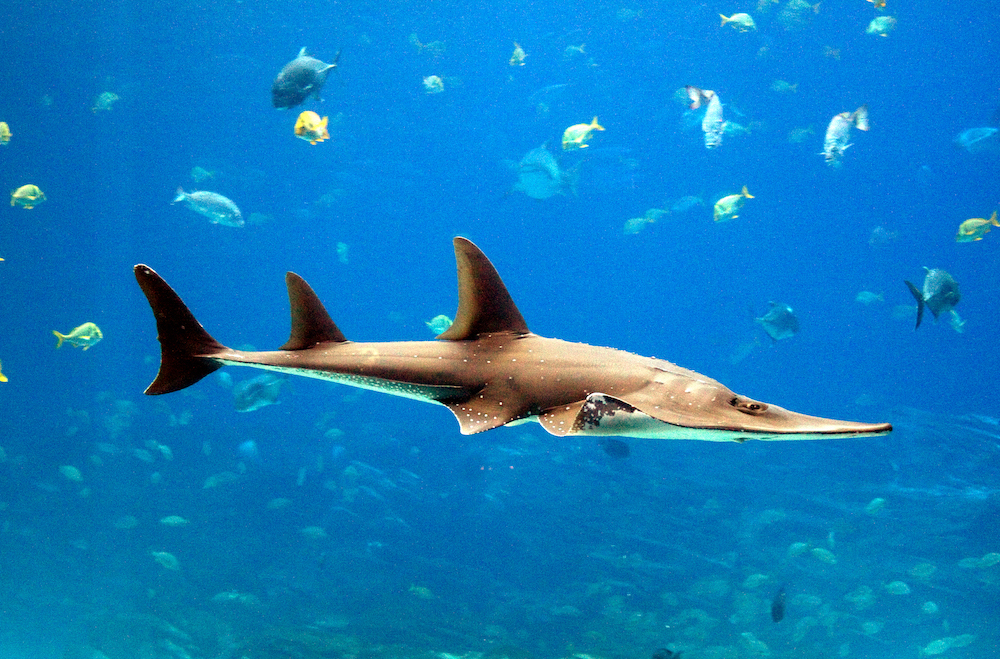Guitarfish Rock–Here’s Why
No strings attached, these rays are true show-stoppers

Here at Ocean Conservancy, we think that all marine wildlife rock. But there’s one animal in particular that I’ve been a superfan of ever since I laid eyes on it: the guitarfish. The name “guitarfish” applies to all rays in the family Rhinobatidae, which is a combination of Latin and Greek words for “nose” and “ray”. Although these rays do look similar to stereotypical rays, they swim with their tails like sharks instead of flapping their fins to move like other rays. Estimated to have been around for more than 100 million years, these animals are truly novel creatures. Take a deep dive with me to learn a few fun facts about one species in particular: the shovelnose guitarfish!
How to spot a guitarfish
Let’s start with the basics: What do guitarfish look like (other than resembling the shape of an instrument?) Along with their compressed bodies, guitarfish have wing-like fins and a pointed snout called a rostrum that helps them secure their prey. Size varies greatly depending on the species; the largest species, the giant guitarfish, can grow to be almost ten feet long and weigh nearly 500 pounds! The shovelnose guitarfish is still relatively large, measuring close to 5.6 feet and measuring upwards of forty pounds. While the term “flat” may have a negative connotation in the music world, flatness is part of what makes the guitarfish so perfectly tuned for its habitat. As bottom-dwellers, the shovelnose spends most of its time on, or very close to, the seafloor in waters typically less than forty feet deep.
The guitarfish’s compressed body does require some specific adaptations when it comes to its anatomy. Since they are bottom feeders, their mouths are located atop a disc on their ventral (bottom) side with blunt, rounded teeth that are perfect for crushing shelled prey. They don’t breathe through the same side that their mouths are on, however; it would be hard to breathe with all the sediment around there. Instead, they have little holes called spiracles on the tops of their heads that help them filter water over their gills much more conveniently.
What they eat
In terms of what they eat, some of guitarfishes’ favorite foods include crustaceans, mollusks, invertebrates such as marine worms and fish. While their diets may sound a bit boring, things get exciting when it comes to their hunting practices. Put simply, guitarfish are all about grand, explosive entrances. Much like the kickoff of a concert where a singer suddenly leaps onto the stage out of nowhere, guitarfish are all about surprising their targets. (They have plans a little less friendly than serenading their unsuspecting prey, however.)
Thanks to their compressed bodies, they bury themselves beneath the sediment while they await their prey. With their inconspicuous eyes protruding just slightly, they wait patiently for their next meal to swim or crawl by—and that’s when the show begins. They strike their prey within seconds, sending an exploding, dusty cloud of sand or mud around them as they leap into action and gobble up their latest catch. If their venue doesn’t appear to be lively enough, they’ll take a little foraging journey, rustling the sediment in case any potential food is hiding undercover.
Where they live
Now, let’s talk more specifically about where shovelnose guitarfish are found. As I mentioned before, these guitarfish generally much prefer shallow waters like bays and estuaries in temperate, tropical and subtropical warm waters. Shovelnose guitarfish are especially known to inhabit areas along the California coast such as Baja Bay.

Mating behaviors
For shovelnose guitarfish, California waters towards the southern coast and Baja Bay also host an incredible spawning area and nursery. In the spring, females that have been carrying and growing eggs for up to a year will visit the area and birth their pups as the water warms. (By the way, all female rays give live birth.) A bit later, males that have reached reproductive maturity (around eight years old) begin to enter the area, and mating occurs. These guitarfish mate monogamously, so they have only one partner per mating season.
Predators and current threats
A few common predators of shovelnose guitarfish include California sea lions, great blue herons and ospreys. While there aren’t many prominent human-induced threats to the species in most California waters, it’s important to know that they are caught as bycatch in net fisheries in northern Mexico and Southern California waters. They are also sought after in some small fisheries, particularly in Mexico. Currently, the Red List of Threatened Species of the International Union for the Conservation of Nature and Natural Resources (IUCN) lists the shovelnose guitarfish as “Near Threatened and Decreasing.” Such ratings, along with their population trendline (decreasing, stable or increasing), reveal a species’ vulnerability to becoming endangered.
The California Department of Fish and Wildlife notes that fewer guitarfish being caught by fishermen may be associated with a “reduction and redistribution of fishing pressure” in the shovelnose guitarfish’s range. This may not be a true reflection of the population size of these rays in California waters. It’s been noted that more monitoring and a more formal and careful assessment of shovelnose guitarfish are necessary to determine more accurately the impacts on their population.
All in all, the fascinating adaptations, curious behaviors and quirky design of these unique creatures are just a few of the things that make guitarfish so endearing—and, in my opinion, true ocean rockstars. Just like all the ocean animals that grace the waters of our ocean, they are worthy of protection and, of course, celebration.
I’ll end with a hilarious quote that I came across while reading the National Marine Sanctuary Foundation’s species outline on guitarfish:
“A guitarfish doesn’t have strings–and even if it did, it would sound a little flat.”